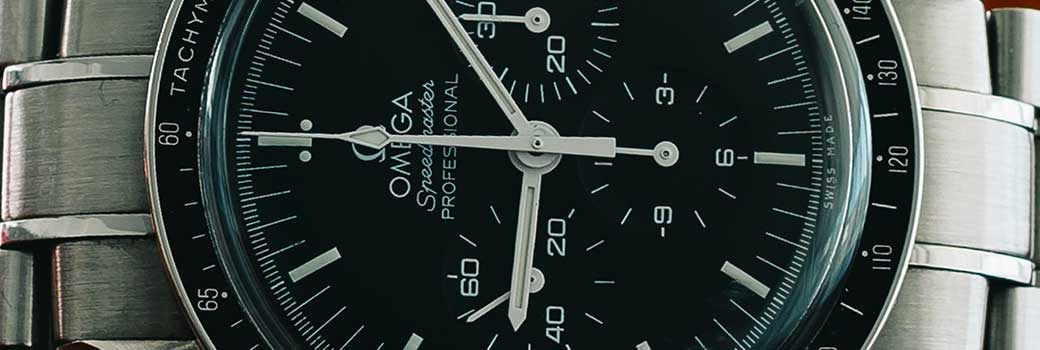One of the most iconic watches in horology is the Omega Speedmaster Professional. It's not the most technically advanced watch or the most expensive. Nor is it rare or even made of exotic materials. What sets the Omega Speedmaster Professional apart is proudly etched in the case back: "The first watch worn on the moon." Not surprisingly, this gives the Omega Speedmaster (nicknamed Speedy) the title of Moonwatch.
Part 2 covers 10 Speedy alternatives that cost less than $600.
The story of the Speedmaster begins before the moon landing when it was designed to time race cars on earth. However, in 1964 when NASA needed to certify a watch for use by astronauts in the Apollo program, it was the only watch to pass all tests. This led to NASA adopting the watch and issuing it to all astronauts including Buzz Aldrin who in 1969 strapped a Speedy to his spacesuit and stepped onto the moon. The Speedmaster also gained fame during the Apollo 13 mission when its chronograph was used to time a 14 second manual burn, which was critical to bringing the astronauts back to earth.
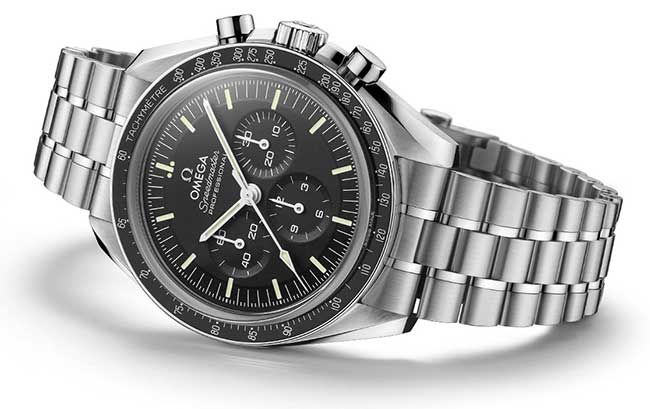
Even today, certain models made in the original pattern include the engraving on the case base "Flight-Qualified by NASA for all Manned Space Missions."
Interestingly the Speedmaster in its original configuration came with a Hesalite crystal, which was about as scratch resistant as plexiglass! But this was deemed an advantage since it would not shatter if broken in space. Here on earth, any scratches can actually be easily polished out with some Polywatch compound at home by the owner. It is also important to note that the Speedmaster is a manually wound watch. It is not automatic and does not have the more modern features of hacking either.
The MSRP of the Omega starts at $6,300 and goes up for limited or special editions. People who buy the Speedy primarily do so for its connection to the space program. However, the layout of the dial is also extremely clean and gives the watch a purposeful feel. It is a fine tool watch even without its horological history. When looking at alternatives, we will consider both watches that mimic the look of the Omega Speedmaster but at a significantly lower price as well as those that have a legitimate connection to the Space Race.
Sinn 140 ST Space Chronograph
Sinn was founded in Frankfurt, Germany in 1961 and has become known for high quality that is typical of German engineered pilot and dive watches. The Sinn dive watches have been adopted by German Navy and police special forces. The connection to space flight came in 1985 when German astronaut Reinhard Furrer wore a Sinn 140 S during a mission to the space station Skylab. Then in 1992 another German astronaut took his Sinn chronograph on a mission to the Mir space station.
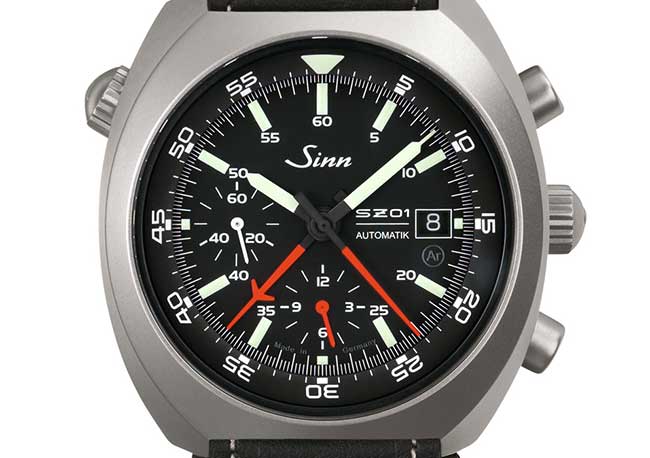
The Sinn case is stainless steel that has been hardened using a process known as Tegiment. This increases the hardness of the stainless steel and makes it much more resistant to scratching. The watch measures 44mm in diameter by 15mm thick and is waterproof to 100m.
The matte black dial includes indices coated with Super Lumi-Nova and the hour and minute hands are also coated in lume. The Sinn 140 Space Chronograph features two sub-dials which track the running seconds and 12 hour chronograph. For tracking the chronograph minutes, the Sinn includes a red fourth minute hand on the main face. This makes tracking the elapsed minutes very easy and even those of us with bad eyes won't have to squint. There is also a date window at the 3 o'clock position.
There is no tachymeter scale on the bezel. Instead Sinn includes a pilot's or Flieger Type B minute track on the inside. If you are familiar with German Flieger watches from WWII, you will immediately recognize this design. Even better, using the crown on the top left allows you to rotate this inner timing bezel. Just like a dive watch, you can use the bezel to time an event separate from the chronograph.
The Sinn 140 is powered by the SZ01 automatic movement which is based on the Lemania 5100 which runs at 28,800 beats per hour and provides a 42 hour power reserve.
The Sinn also features their unique Ar-Dehumidifying Technology that includes a replaceable drying capsule that slows the aging of the internal lubricating oils due to moisture (which translates into longer service intervals) as well as prevents the crystal from fogging when it is suddenly immersed in the cold – such as in outer space.
The MSRP for the Sinn 140 Space Chronograph is $4,999. This is not inexpensive but is still less than the Speedy and offers a legitimate space watch with its own unique style and function.
| Sinn 140ST | Omega Speedmaster | |
|---|---|---|
| Case size x thickness | 44mm x 15mm | 42mm x 13.2mm |
| Water resistance | 100m | 50m |
| Tachymeter | ✘ | ✔ |
| Rotating bezel | ✔ | ✘ |
| Sub-dials | Seconds, 60 min., 12 hr. | Seconds, 30 min., 12 hr. |
| Crystal | Sapphire | Hesalite |
| Display case back | ✘ | ✘ |
| Movement | Sinn SZ01 | Omega 3861 Co-Axial |
| Movement type | Automatic | Hand-winding |
| Beat rate | 28,800 | 21,600 |
| Power reserve | 42 | 48 |
| Been in space | ✔ | ✔ |
| MSRP | $4,999 | $6,300 |
| Buy | See the best price | See the best price |
Fortis Official Cosmonaut B-42 Chronograph
Fortis is a luxury Swiss watch company founded in 1912. It has become known for its association with various NATO military organizations and supplies watches to the Jagdgeschwade in Germany, the Swiss 11 Fighters, and the Hellenic Tigers of Greece. But in 1994, Fortis was selected as the official watch supplier for the Russian Federal Space Agency.
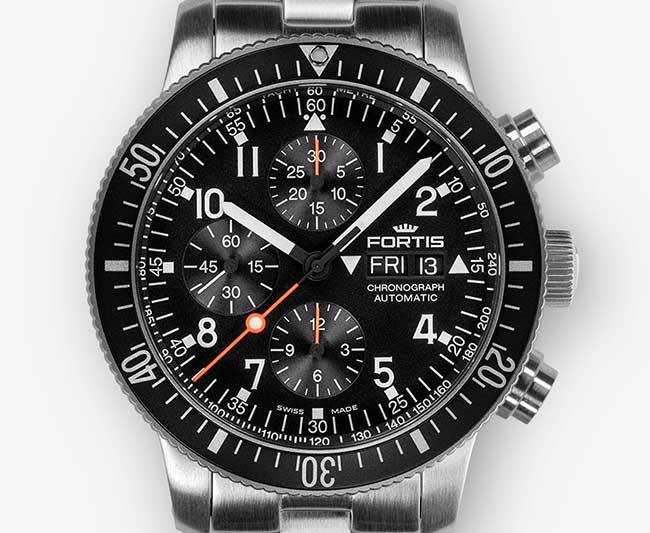
Since then, it has been used by Russian cosmonauts on all missions to the Mir space station and the International Space Station. According to Fortis, the Cosmonaut B-42 has logged more than 100,000 Earth orbits, which gives it the record of the watch with the longest use in weightless conditions.
The Fortis Cosmonaut B-42 is a black dialed automatic chronograph with an accent color on the second hand to improve visibility. It is 42mm in diameter and sports a rotating aluminum bezel with countdown time markings etched on the outside and a printed tachymeter scale inside the bezel.
The case is a handsome brushed finish and offers 200m of water resistance, which is very good for a chronograph. A sapphire crystal with AR coating completes the package.
Inside is Valjoux 7750 based movement (called the UW-50), which is a high beat self-winding chronograph movement with a power reserve of 48 hours.
The watch comes with a very solid stainless steel bracelet. However, as with all space watches, a true astronaut (or cosmonaut) would wear it on a long velcro band or NATO strap over their spacesuit.
The MSRP for the Fortis B-42 is $3,250, which makes it about half the price of the Omega Speedmaster but with an equally compelling role in space.
| Fortis Cosmonaut | Omega Speedmaster | |
|---|---|---|
| Case size x thickness | 42mm x 15.5mm | 42mm x 13.2mm |
| Water resistance | 200m | 50m |
| Tachymeter | ✔ | ✔ |
| Rotating bezel | ✔ | ✘ |
| Sub-dials | Seconds, 30 min., 12 hr. | Seconds, 30 min., 12 hr. |
| Crystal | Sapphire | Hesalite |
| Display case back | ✘ | ✘ |
| Movement | Valjoux 7750 | Omega 3861 Co-Axial |
| Movement type | Automatic | Hand-winding |
| Beat rate | 28,800 | 21,600 |
| Power reserve | 44 | 48 |
| Been in space | ✔ | ✔ |
| MSRP | $3,250 | $6,300 |
| Buy | See the best price | See the best price |
Farer Chronograph Sport Moritz
This Swiss made watch comes from the British owned watch company Farer. Established in 2015, this new company designs all of their watches in Britain and then works with their Swiss manufacturing partner, Roventa-Henex, to craft the watch.
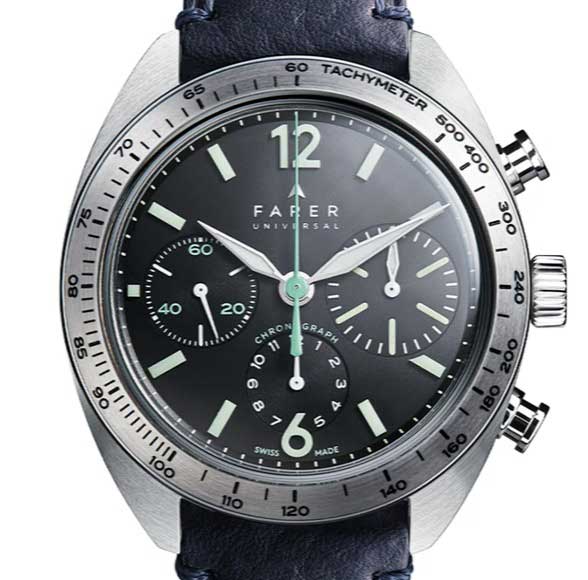
At first glance, the Farer Moritz clearly takes some styling cues from the Speedmaster. It has a simple, easy to read dial and debossed sub-dial layout. The tachymeter around the bezel gives the watch a very instrument look and clearly delineates it as a tool watch. The Moritz also uses a hand wound movement just like the Speedy which allows them to keep the watch thin and supremely comfortable. You won't be snagging this watch against your sleeves or door jams.
The dial is a matte black with Super Lumi-Nova applied Arabic numerals at 12 and 6 and markers with white and mint green markings. There is a big-eye sub-dial at 3 o'clock. The hands are polished steel outlined with Super Lumi-Nova infill.
The case size is 41mm in diameter and 11mm thick although with the domed sapphire crystal and exhibition case back, the overall thickness increases to 12.9mm. It offers a water resistance of 100m.
Inside is the Sellita SW510 BH Elaboré grade manual movement. The movement is decorated and viewable through the sapphire crystal display back. The second sweep as a smooth 28,800 beats per hour with approximately 58 hours of power reserve.
The MSRP is $1,955 on a leather strap, and Farer also offers a steel bracelet for an additional $140. But again a true space watch is probably on velcro anyway. The Farer Moritz has not been to space, but it does offer one of the closest alternatives to the specs of the original Speedmaster at one-third of the cost.
| Farer Moritz | Omega Speedmaster | |
|---|---|---|
| Case size x thickness | 41mm x 12.9mm | 42mm x 13.2mm |
| Water resistance | 100m | 50m |
| Tachymeter | ✔ | ✔ |
| Rotating bezel | ✘ | ✘ |
| Sub-dials | Seconds, 30 min., 12 hr. | Seconds, 30 min., 12 hr. |
| Crystal | Sapphire | Hesalite |
| Display case back | ✔ | ✘ |
| Movement | Sellita SW510 BH | Omega 3861 Co-Axial |
| Movement type | Hand-winding | Hand-winding |
| Beat rate | 28,800 | 21,600 |
| Power reserve | 58 | 48 |
| Been in space | ✘ | ✔ |
| MSRP | $1,955 | $6,300 |
| Buy | See the best price | See the best price |
TAG Heuer Formula 1
On February 22, 1962, astronaut John Glenn wore a Heuer stopwatch attached by an elastic band to his spacesuit, three times around the world on his spacecraft, Friendship 7. This made the Heuer the first Swiss timepiece to go to space. TAG Heuer has a long connection with racing and aviation so it should come as no surprise that one alternative to the Omega Speedmaster would be a TAG Heuer.
Now, you would not be wrong to argue that the TAG Heuer Carrera is a better option and in many ways it is. But with a retail price just under that of the Omega Speedmaster, one could also argue that if you are willing to spend that much on a Carrera, you might as well just get the Speedy. In 2012, TAG Heuer teamed with SpaceX to send a special edition of the Carrera into space on the Dragon 9 capsule. Unfortunately, only 2,012 were made, and now the piece is difficult to find and costs much more than a new Speedy.
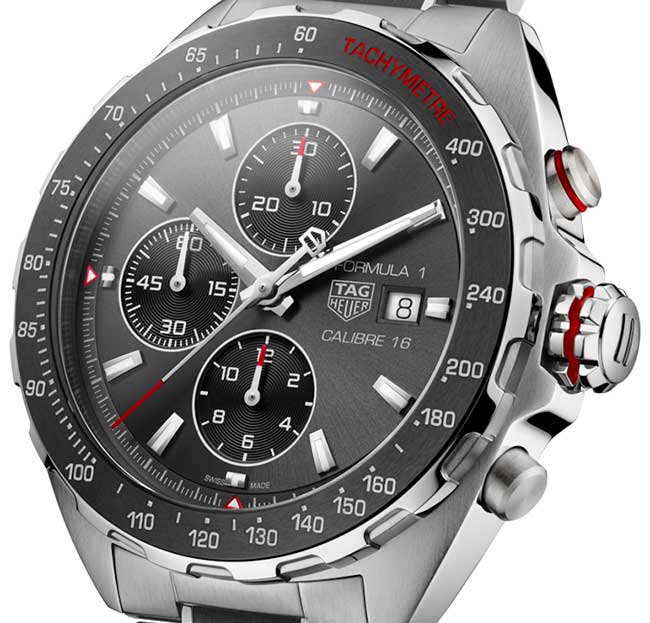
The Formula 1, on the other hand, has a design similar to the Carrera but uses either the Calibre 16 Automatic movement or a Swiss Quartz movement which drops the price dramatically.
Both the automatic and quartz Formula 1 are similar in design and construction. So while we'll be focusing on the automatic version, the quartz is basically the same (with a few differences noted below) and of course much more affordable.
The TAG Heuer Formula 1 is made of stainless steel and is 44mm in diameter by 15mm thick. The fixed stainless steel bezel has the required tachymeter markings. There are several face colors, but the black version includes luminous silver-tone hands and applied index hour markers. There is a date display at 3 o'clock. The sub dials display a running seconds and 30 minute and 12 hour chronograph totalizer. The red tips on the chronograph hands are a welcome touch and really aid in readability.
The quartz version of the Formula 1 is slightly smaller at 43mm in diameter and a lot thinner at 11.5mm. This thinness is one advantage of the Quartz movement. Also, the sub dial setup is slightly different on the quartz displaying the running seconds and for the chronograph measuring 1/10 of a second and elapsed minutes. This makes the timing more accurate and somewhat mesmerizing to look at with the quartz.
Both use scratch resistant sapphire crystal with solid case backs. The TAG Heuer Formula 1 offers 200m of water resistance, which is rare for chronographs. Strap options come in fine brushed stainless steel with folding clasp and push buttons as well as various types of rubber and leather.
Powering the TAG Heuer Formula 1 is the Calibre 16 automatic movement, which is based on the tried and true Valjoux 7750. The movement runs at a high beat rate of 28,800 bph with a power reserve of 42 hours.
The price of the quartz is about $1,550, and the automatic clocks in at $2,850. While these are not cheap (especially for a quartz), the style and fit and finish will rival that of the Omega. Plus, you get a universally recognized brand that is synonymous with luxury.
| Tag Formula 1 (Quartz) | Tag Formula 1 (Auto) | Omega Speedmaster | |
|---|---|---|---|
| Case size x thickness | 43mm x 11.5mm | 44mm x 15mm | 42mm x 13.2mm |
| Water resistance | 200m | 200m | 50m |
| Tachymeter | ✔ | ✔ | ✔ |
| Rotating bezel | ✘ | ✘ | ✘ |
| Sub-dials | Seconds, 1/10 sec., 30 min. | Seconds, 30 min., 12 hr. | Seconds, 30 min., 12 hr. |
| Crystal | Sapphire | Sapphire | Hesalite |
| Display case back | ✘ | ✘ | ✘ |
| Movement | Swiss Quartz | Tag Calibre 16 | Omega 3861 Co-Axial |
| Movement type | Battery | Automatic | Hand-winding |
| Beat rate | - | 28,800 | 21,600 |
| Power reserve | 2 years | 42 | 48 |
| Been in space | ✘ | ✘ | ✔ |
| MSRP | $1,550 | $2,850 | $6,300 |
| Buy | See the best price | See the best price | See the best price |
Conclusion
The Omega Speedmaster Moonwatch is an amazing timepiece with a stellar historical connection to space. However, it is not the only watch that has been in space nor is it the most advanced in terms of construction and technology. Whether you are looking for a watch that can claim to be a true space watch or just prefer the clean interface of the Speedy but don't want to pay a premium for the history, you'll find that any of the above would make a great alternative.
Curious what kind of Speedmaster you can get for less than $600? Head over to Part 2 and find out.
Honorable Mentions
There are few legitimate "space watches" that I could have included but did not. Here are two of the most notable.
Breitling Navitimer Cosmonaute. This was was known as the watch Scott Carpenter wore on his Mercury mission in May 24, 1962. This made the Navitimer one of the first wristwatches in space. The problem for this article is that if you can find one new it will cost several thousand dollars more than a new Omega Speedmaster Professional. So while it is historically important it is not really an "alternative" to the Speedy in terms of availability and price.
Rolex GMT Master. On the final Apollo mission, astronaut Ronald Evans took a Rolex GMT Master to the moon. So Rolex can claim to be the "second" watch on the moon. It just doesn't have the same ring as being first, does it? And as with all things Rolex, it is very difficult to find a Rolex GMT at your authorized dealer and even if you do, it will cost twice as much as an Omega Speedmaster.
Curious what kind of Speedmaster you can get for less than $600? Head over to Part 2 and find out.
What do you think about these watches? Did we miss a great alternative? Please leave your comments below.
